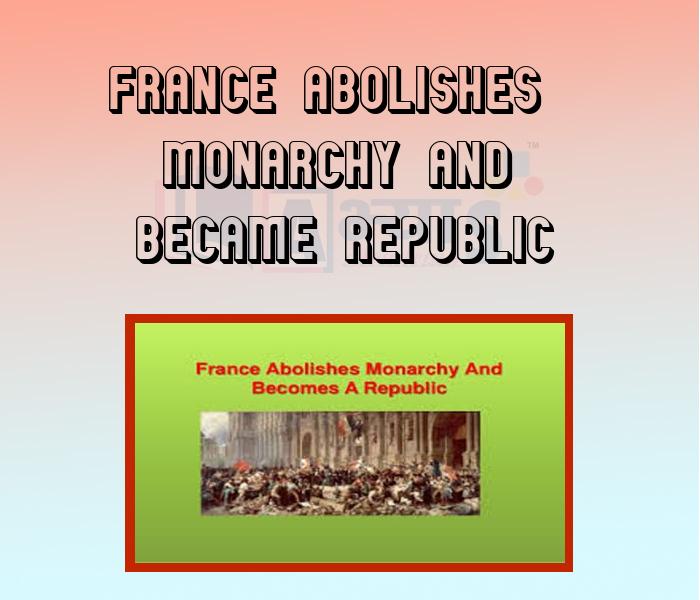France Abolishes Monarchy And Becomes Republic













France Abolishes Monarchy And Becomes Republic
France Abolishes Monarchy And Becomes A Republic: The situation in France continued to be tensed in subsequent years. Even though Louis XVI had signed the Constitution, he entered into secret negotiations with the King of Prussia. Rulers of France’s neighbouring countries were worried by the developments in France. They made plans to send troops to put down the events taking place since 1789. Before this could happen, the National Assembly declared war against Prussia and Austria in April 1792. Thousands of volunteers joined army who saw war as a protest of the people against kings and aristocracies all over Europe. Among the patriotic songs sung by them was the Marseillaise composed by the poet Roget de L’Isle. It later became the National Anthem of France. It was sung for the first time by volunteers from Marseilles as they marched into Paris. This way it got its name.
In the France abolishes monarchy depicted some symbols and some basic value
The Result of Revolutionary Wars: Economic difficulties and losses were the result of the revolutionary wars. While men were busy fighting at the front, women had to earn a living and look after their families. A large segment of the population was convinced that the revolution had to be carried further, as the Constitution of 1791 gave political rights only to the richer section. Political clubs became popular, where people could discuss government policies and their own plans of action. The most successful of these clubs was that of the Jacobins, which got its name from the former convent of St Jacob in Paris.
The Jacobin Club: Members of the Jacobins club belonged mainly to the less prosperous sections of society. They included shopkeepers, artisans, cooks, shoe-makers, watch-makers, printers, servants and daily-wage workers. Their leader was Maximilien Robespierre.
They dressed differently by wearing long striped trousers similar to those worn by dock workers. They wanted to show themselves apart from the fashionable sections of society, especially the nobles, who wore knee length breeches.
It was a way of declaring the end of the power holded by the wearers of knee breeches. They came to be known as sans-culottes’ meaning ‘those without knee breeches’. Sans-culottes men wore a red cap that symbolised liberty.
The Convention: On 10th August, 1792, the Jacobins attacked the Palace of the Tuileries with large number of Parisians. They killed the king’s guards and held the king himself as hostage for several hours. Later, the assembly voted to imprison the royal family. Elections were held and now all men above 21 years of age were allowed to vote. The newly elected assembly, called the Convention. It abolished monarchy on 21st September, 1792 and France was declared a ‘Republic’. A republic was a form of government where the people elected the government, including the head of the government. There is no hereditary monarch. Louis XVI was sentenced to death by a court on the charge of treason. On 21st January, 1793, he was executed publicly at the Place de la Concorde. After some time, the Queen Marie Antoinette met with the same fate.
Members of the Jacbbin Club were known as __________________ | |||
| Right Option : D | |||
| View Explanation | |||
Who were the members of the Jacobin Club? | |||
| Right Option : B | |||
| View Explanation | |||
French legacy to the world as _______________________ | |||
| Right Option : D | |||
| View Explanation | |||
Students / Parents Reviews [10]
It was a good experience with Abhyas Academy. I even faced problems in starting but slowly and steadily overcomed. Especially reasoning classes helped me a lot.

Cheshta
10thIt has a great methodology. Students here can get analysis to their test quickly.We can learn easily through PPTs and the testing methods are good. We know that where we have to practice

Barkha Arora
10thAbout Abhyas metholodology the teachers are very nice and hardworking toward students.The Centre Head Mrs Anu Sethi is also a brilliant teacher.Abhyas has taught me how to overcome problems and has always taken my doubts and suppoeted me.

Shreya Shrivastava
8thOne of the best institutes to develope a child interest in studies.Provides SST and English knowledge also unlike other institutes. Teachers are co operative and friendly online tests andPPT develope practical knowledge also.

Aman Kumar Shrivastava
10thA marvelous experience with Abhyas. I am glad to share that my ward has achieved more than enough at the Ambala ABHYAS centre. Years have passed on and more and more he has gained. May the centre flourish and develop day by day by the grace of God.

Archit Segal
7thMy experience was very good with Abhyas academy. I am studying here from 6th class and I am satisfied by its results in my life. I improved a lot here ahead of school syllabus.

Ayan Ghosh
8thMy experience with Abhyas academy is very good. I did not think that my every subject coming here will be so strong. The main thing is that the online tests had made me learn here more things.

Hiya Gupta
8thAbhyas Methodology is very good. It is based on according to student and each child manages accordingly to its properly. Methodology has improved the abilities of students to shine them in future.

Manish Kumar
10thAbhyas is a complete education Institute. Here extreme care is taken by teacher with the help of regular exam. Extra classes also conducted by the institute, if the student is weak.

Om Umang
10thBeing a parent, I saw my daughter improvement in her studies by seeing a good result in all day to day compititive exam TMO, NSO, IEO etc and as well as studies. I have got a fruitful result from my daughter.
